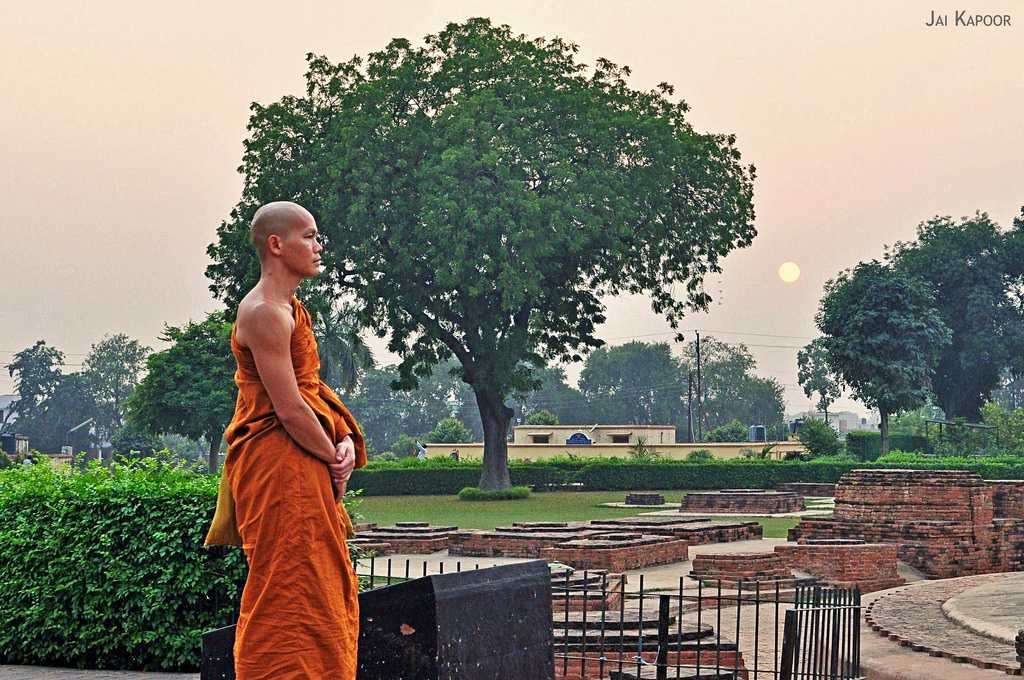"One of the four holiest places to the Buddhists"
Sarnath Tourism
A quiet and spiritual town set amidst the otherwise densely populated state of Uttar Pradesh, Sarnath is a city of historical marvel with numerous Buddhist stupas, museums, excavated ancient sites and beautiful temples that prove to be a source of immense wonder and astonishment to tourists due to their mystical and serene setting. Being just 10 kms from Varanasi, Sarnath is often flocked with devotees is the perfect pilgrimage site for Buddhists, Jains and Hindus, alike.
A pilgrimage place for Buddhists, Sarnath features a number of temples and completely serene surroundings with its various historically significant, architectural marvels. Being the place where Lord Buddha preached his first sermon, Sarnath has since been a popular tourist attraction and is well known for its cultural significance as well as the mystical setting. To name a few attractions contributing to the spiritual significance of Sarnath, we have, Ashoka's Pillar, Dharma Stupa built by Emperor Ashoka and many more.
Download Sarnath PDF Guide >
What's Great?
Peaceful environment and surroundings.
What's not so Great?
Scalding in summers. Not much to explore.
For Whom
Sarnath is one of the major Buddhist pilgrim centres in the world. Apart from pilgrims, Sarnath is a major attraction for historians, architects and linguists.
History of Sarnath
Buddhism, as a philosophy of life and as we know of it today, is followed in many countries with over 400 million followers worldwide - yet, very few know that inside of Sarnath is in fact, the place called the Deer Park where Buddha came to give his first sermon, after receiving enlightenment under the Bodhi Tree, at Bodhgaya. Sarnath derives its name from Sarangnath or the Deer God, and hence the place becomes truly special in symbolism. Since then, it has become part of the four key sites in the Buddhist circuit. It is also an important Jain pilgrimage site as it is the birthplace of Shreyansanath, the Eleventh Tirthankara of Jainism, and there is a temple dedicated to him here. After this, Sarnath went through a series of historical upheavals, right from 3rd Century BC, when Emperor Ashoka took special interest in this place and built magnificent structures like giant stupas, a well engraved Ashokan pillar and Buddhist monasteries for monks to reside in peacefully to approximately 10th to 12th Century BC, when a series of prolonged invasions by foreign invaders annihilated the cities of modern-day Uttar Pradesh, and left Sarnath in crumbles. It was only in the mid 19th Century when Sarnath was preserved again for its historical significance by some British archaeologists and Sarnath regained its position of being one of the most important pilgrimage sites for Buddhism.
The City of Enlightenment
Located close to the confluence of rivers Ganges and Varuna, Sarnath is one of the major Buddhist pilgrimage sites in the world. An ancient city, dating back to 528 BC, Sarnath is believed to be the first place where Lord Buddha started preaching and laid the foundation of Buddhism. An example of rich cultural heritage and spiritual legacy, Sarnath is also the origin of our national Emblem, sourced from one of the most significant contributions of Emperor Ashoka-the Lion Capital.
Itinerary
Day 1:Start off your tour with a visit to the Buddhist temples like the Thai temple, Dhamekh Stupa, the Chaukhandi Stupa and the Archaeological Museum.
NOTE:It is best to stay at Varanasi and spend a full day at Sarnath.
Restaurants and Local Food in Sarnath
Sarnath does not have too many restaurants but the handful that it does offer delicious food. The food is mainly North- Indian, with some of its most popular delicacies. One can also enjoy typical and popular bits of Chinese cuisine in the area. Along with these one can also find some instances of Tibetan cuisine here such asMomos.There are also some joints serving traditional snacks.
View 3 Restaurants in Sarnath >>
Oct-Maris the best time to visit Sarnath
October to March are the best months to visit Sarnath. It is best to avoid visiting the place from April to October as the area experiences scorching heat and it becomes difficult to sightsee. One may also want to consider the various festivals celebrated here which fill the area with the colours and chants of spirituality while marking out dates. Some of these are Buddha Poornima (May), and Maha Shivaratri (February- March)
Weather in Sarnath
Loading...
Sarnath in Summer (March-June)
Summer temperature in Sarnath ranges between 25 to 45 degrees Celcius. The hot and humid climate attracts fewer tourists during this season leading to a drop in hotel prices. It is best to avoid visiting during the summer months.
Sarnath in Monsoon (July - September)
Monsoons bring high rainfall in the region. Rains bring down the temperature of Sarnath and restore comfortable weather in the region.
Sarnath in Winter (November-February)
Though winter mornings in Sarnath are pleasant and ideal for sightseeing, the town receives chilly nights. Temperature ranges from 15 to 3 degrees Celcius during this season. It is best to visit Sarnath during these months.
Monthly Weather in Sarnath
Month
Avg. Minimum (°C)
Avg. Maximum (°C)
January
11
23
February
13
28
March
17
32
April
25
39
May
27
39
June
28
38
July
27
32
August
27
33
September
26
31
October
22
32
November
15
28
December
12
22
Events in Sarnath
Buddha Poornima
22nd May
To mark the birth, enlightenment and salvation of Gautam Buddha, celebrations are held in Sarnath every year.One of the most important places of worship for Buddhist pilgrims, thousands from all over the world-Tibet, Thailand etc- throng to Sarnath for these celebrations. Day long prayers are held, along with free medical camps for the poor. In the evening the lighting of lamps is done at the Bodhi Tree, and other significant places.
Comments on Sarnath
Post Your Comment


 Chaukhandi Stupa
Chaukhandi Stupa Ashoka Pillar
Ashoka Pillar Thai Temple
Thai Temple Tibetan Temple
Tibetan Temple Varanasi
Varanasi Vindhyachal
Vindhyachal Allahabad
Allahabad Agra
Agra Khajuraho
Khajuraho Bodh Gaya
Bodh Gaya